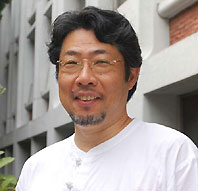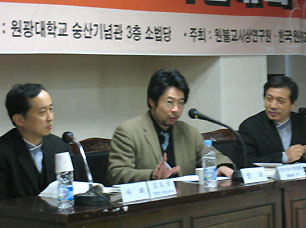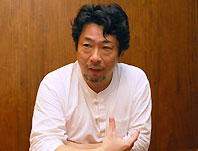Naoki Kashio, Associate Professor, Faculty of Letters
Exploring bonds between people, and bonds between people and the world, based on the keyword of “spirituality”
Naoki Kashio

Graduated from the Faculty of Economics at Keio University in 1986. Withdrawal from the Doctoral Program with the completion of course requirements, Graduate School of Humanities and Sociology, University of Tokyo in 1995.
Served as Assistant Lecturer in the School of Human Sciences, Waseda University, Assistant Lecturer in the Faculty of Foreign Languages, Tokyo University of Foreign Languages, and others, before taking up his present post as Associate Professor specializing in Social Science in the Department of Humanities and Social Science, Faculty of Letters, Keio University.
Researches modern human relationships, the nature of bonds, religious awareness and culture based on the keyword of "spirituality". Classes are unique, as revealed in the monograph Maikeru Sanderu ga sasou “Nihon no hakunetsu jugyo” e yokoso (Welcome to a Japanese “Justice with Michael Sandel”). Many publications and edited works include Supirichuaru Raifu no Susume (Recommendations for a Spiritual Life), Supirichuariti Kakumei (Spirituality Revolution) and Supirichuariti wo Ikiru (Living Spirituality).
A universal quest transcending time and space

─ First of all, how exactly do you define "spirituality"?
Spirituality, in a nutshell, is “a power or a presence that transcends this world and human comprehension”; it could be called “the essence of religion”. Spirituality is also thought to be an elevated consciousness beyond the limits of the mind, a quest for the true meaning of life. This is not limited to the modern era, but could be seen as a universal quest that has existed since the dawn of mankind.
Spirituality is seen as consisting of “philosophical desire” and “religious desire”. “Philosophical desire” has themes such as the purpose, meaning and significance of life, where human beings came from and where we are going, as well as the significance attached to those. “Religious desire” comprises themes such as supernatural beings and gods, eternal life, etc., and the significance attached to them. We could see both of these as universal quests that transcend time and space.
─ What are your thoughts on the recent boom in spirituality?
In the past, spiritual culture was carried along by religion, and religion is losing its hold on people. This does not, however, diminish people’s interest in things that cannot be seen but transcend time and space. I think there is now growing interest in those things as part of a spiritual culture that unites various realms of social culture, including health, food, ecology, and education.
Since the 1960s, there has been increasing attention on spirituality in the United States, Britain and other western countries. In Japan, interest started to grow in the 1980s, in connection with end-of-life care for terminally ill cancer patients, welfare, symbiosis with nature, the value of life, and so on. And since the turn of the century, there has been a “spiritual boom” fueled by television and other media. On the other hand, there is also a tendency for completely uncorroborated spiritual phenomena to be accepted as a matter of course. There is some concern over the dangers inherent in this.
─ We also hear a lot about "powerspots" in the media. What's your take on this kind of socio-cultural phenomenon?
“Powerspots” became fashionable in the second half of the 1980’s. These are traditional religious sites, forests and other unique places noted for their rich natural surroundings, such as the utaki sacred spots on Okinawa island, the remote island of Kudaka, the ancient shrine at Ise or the old Kumano Highway.
Originally, just visiting these places with their vast natural settings, some including forests with trees hundreds of years old, could be a source of refreshment in itself. People would visit them when they wanted to get away from a stress-filled life and recharge their batteries or heal themselves. Indeed, this could be a modern expression of a universal desire unique to humans – wanting to revitalize weary souls and seeking a moment of repose.
Research themes include meditative experiences as well as theory

─ How did you get involved in research on spirituality?
I majored in the History of Social Thought in Keio’s Faculty of Economics. Here I learnt about Max Weber, who laid the foundations for sociology, Hisao Otsuka, who created the system known as “Otsuka history studies” focusing on the establishment of capitalism in Europe, and Emile Durkheim, French researcher in the sociology of religion, among others. Through these studies, I realized how important religion is as a theme in creating bonds between people. I then moved up to graduate school at Tokyo University and started my research in “religious studies”.
From around the end of the Master’s course, I started to be interested not only in research on the theory of religion, but also in anthropological and ethnological fieldwork. I started to research things like the “Tsuburosashi” folk festival held on Sado Island in Niigata Prefecture. There, rather than feeling the vivid power of religion, I discovered the reality of studying spiritual elements sought by contemporary people in a new religion.
And so, when I was 29, I started researching the spirituality of believers, taking the basic theme of a new Japanese-derived religion in France; for example, how the members of religious cults form their sense of collectiveness. In the process of gathering survey material in the field, I noticed that, even though I understood spirituality in terms of knowledge, I did not understand it physically.
─ What kind of things didn't you understand?
That spirituality means knowing that people and the world are originally one and the same, and that we are tied to it by unseen bonds. Let us assume, for example, that this world was formed by the cosmic “big bang”. After an immense span of time, this world divided off into flowers, trees, rocks, insects, and humans. What is important here, is that the monistic attitude that we are originally all one and the same is internalized and expressed in the way we live. I understood that, but only in my head.
Then I wondered how I could understand this not only through knowledge but also through physical experience. The result was that, in June 2009, I started Zen meditation in Busan, South Korea. After that, I practiced and experienced Tao meditation, Vipassana meditation of Theravada Buddhism, basic yoga, Korean seon, and various other types of meditation. This led me to tackle the new research theme of “comparative meditation theory”.
Examining the meaning of life and religion in a conversational tutorial style

─ Now could you tell us something about your classes at the university?
My classes are based on group discussion. Although the themes raised are different year to year, in the first case I might start by asking the students what mental associations they have with the word “religion”. Their answers divide clearly into negative and positive groups, such as “suspicious” and “money” as against “shrines” and “mental support”. So then I have them discuss why attitudes to religion are so polarized, until finally, they think the answers out for themselves. Rather than having them memorize academic definitions, I try to get them to understand “what is religion” in everyday conversation, using their own everyday expressions.
Through this process of discussing and finding their own answers, their perceptions start to distinguish between what is religious and what is not. And then they go on to think about religions as cults. In my classes in the second semester last year, I had the students discuss “religious aspects of Hayao Miyazaki’s animation”, as part of an attempt to delve deeper into the question of what religion is.
─ Do you ever actually incorporate meditative experiences in your classes?
In the first semester this year, I plan to lecture on “The potential for a new sociology of religion”, and in the second semester to practice “meditative experience”. In the past I have done this experimentally on the Hiyoshi Campus, but I think this will be the first attempt to incorporate Zen meditation in actual classes on the Mita Campus.
─ Finally, could you tell us about your future research themes?
I mentioned earlier that I had the opportunity to experience various meditative practices in Busan; “constructing a general theory of comparative meditation and ritual” through physical practice is now an important theme for me. Although there are different methods of meditation and ritual depending on the religion, I think meditation and ritual are cultural devices that create close human relationships and strengthen bonds with the outside world. Until now there has been no research on what kind of bonds are created by meditation and ritual practiced in various religions. I will also attempt to verify the physical significance of their respective rituals, and to collaborate with researchers in electrophysiology, medicine and other natural sciences. I think that by conducting comparative research on different religions from various angles, such as unraveling past literature to see how their rituals have been expressed in words, I will be able to delve more deeply into the bonds created by religious phenomena.
*This article appeared in "Kenkyu Saizensen" (Oct. 3, 2011) of Keio University Japanese Website.
